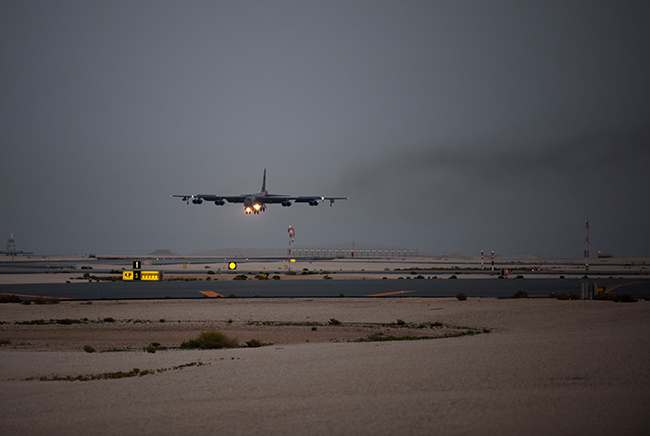
A US B-52H Stratofortress aircraft assigned to the 20th Expeditionary Bomb Squadron comes in for a landing on May 8, 2019. Air Force photo by SSgt. Ashley Gardner.
Hours after a British general and senior coalition member told reporters “there was no increased threat from Iranian-backed forces in Iraq and Syria,” US Central Command issued a statement saying that’s not true.
“Recent comments from OIR’s deputy commander run counter to the identified credible threats available to intelligence from US and allies regarding Iranian-backed forces in the region,” US Navy Capt. Bill Urban, lead spokesman for US Central Command, said in the statement. “Central Command, in coordination with Operation Inherent Resolve, has increased the force posture level for all service members assigned to OIR in Iraq and Syria. As a result, OIR is now at a high level of alert as we continue to closely monitor credible and possibly imminent threats to US forces in Iraq.”
The statement contradicts comments made by British Army Maj. Gen. Christopher Ghika earlier in the day regarding the Iranian threat.
“Am I concerned about the danger: no, not really,” Ghika said. “We take a range of force protection measures for operating in this part of the world against a whole range of threats, and we review them regularly. We’ve reviewed them, obviously, in light of the events in the last week or so.”
Ghika was careful to clarify the coalition’s mission only focuses on ISIS inside Iraq and Syria, and not actions taken by neighboring nations.
However, a recent inspector general report to Congress on Operation Inherent Resolve, noted that even though Iran continues to fight ISIS in Syria, it also “maintains a substantial capability to threaten US forces in Syria through the Islamic Revolutionary Guard Corps—a branch of Iran’s Armed Forces—and Iranian-backed proxy forces operating in Syria.”
The report also highlights a “continuing lack of discipline and criminal activity” by Iranian-linked militias like the Popular Mobilization Forces, or PMF, which in February cracked down on leaders who “criticized Iranian influence in Iraq,” according to the report.
“We have a range of force protection measures to protect us against those threats, which we raise and reduce according to the nature of the threat,” Ghika said.
The US military has deployed a B-52 Bomber Task Force, the USS Abraham Lincoln Carrier Strike Group, and other assets to US Central Command in response to intelligence that cited “very, very credible” threats to US forces and interests in the region. B-52s, along with F-15s and F-35s, this week began flying deterrence missions in the region.
Iran’s ambassador to the United Kingdom, Hamid Baeidinejad, told reporters in London the recent US deployments risked a “serious miscalculation,” according to USA Today. President Donald Trump, speaking in the Oval Office on May 14, warned Iran that if it did “anything” to attack the US, “they will suffer greatly.”
The Pentagon last week reportedly presented a plan to send up to 120,000 troops to the Middle East if Iran did attack American forces or accelerate its work on nuclear weapons, The New York Times reported. Trump, when asked about the report, said it is “fake news,” adding, “We’re not going to have to plan for that, and if we did that, we’d send a helluva lot more troops than that.”